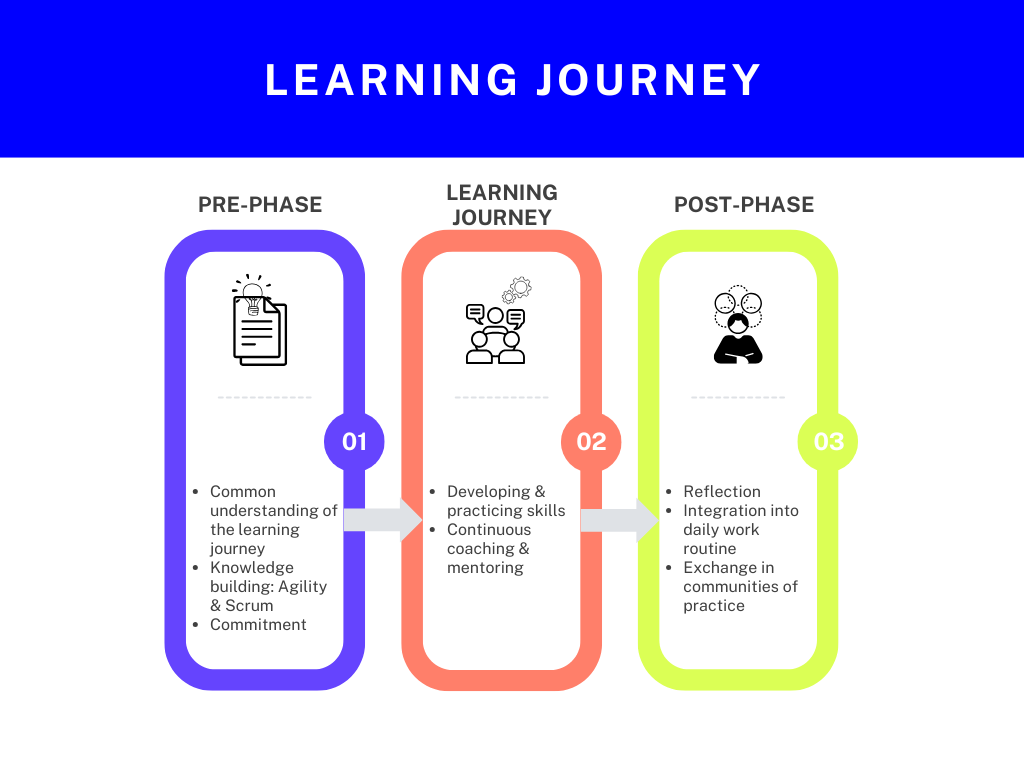The role of a Scrum Master is one of the key roles in agile organizations. But how do you become a successful Scrum Master who leads teams through the challenges of agile projects? The path to this goal is not a one-time training course, but a learning journey that must be tested in practice and continuously developed. Because in reality, training is much more likely to be unsuccessful than it works; out of 100 participants, only about 20% can use what they have learned to improve their work performance.
The learning journey requires an understanding of agile principles, continuous learning, and the expertise to empower teams. In this blog post, we describe the path to becoming a successful Scrum Master and provide valuable insights into the learning methods that should accompany this path.
The Journey of a Scrum Master
Phases of the learning journey
A learning journey can generally be divided into three main phases, which structure the process of acquiring and applying knowledge:
- Pre-phase (preparation phase): In this phase, the foundations are laid. The prospective Scrum Master prepares for the learning journey by acquiring theoretical knowledge about Agile and the Scrum framework. This phase serves to develop knowledge and a basic theoretical understanding of the principles and values that will shape the rest of the journey. In the pre-phase, the focus is on training, literature study and e-learning modules that convey the agile mindset and principles of Scrum.
- Training phase (learning and practicing): In this central phase of the learning journey, the prospective Scrum Master applies the knowledge learned in real or simulated projects. The focus is on the application of Scrum principles and techniques in practice. Scrum events such as Sprint Planning, Daily Scrum and Sprint Reviews are practiced under guidance. At this stage, feedback loops, mentoring, and working in real teams play a crucial role. The training phase promotes the role understanding of the Scrum Master.
- Post-phase (sustainable application): After the intensive training phase, it is important to integrate what you have learned into everyday work in the long term. This phase is about consolidating and developing the knowledge acquired through continuous practice. Reflection, continuous feedback and the exchange with other Scrum Masters in “Communities of Practice” play a central role in this phase.

Learning blocks on a Scrum Master’s learning journey
As part of these phases, the Scrum Master goes through various learning blocks that build on each other and help to develop theoretical and practical skills that are needed in their daily work. Here are the most important learning blocks:
- Understand the basics of Agile and Scrum
Abilities:
- Agile Mindset: The Scrum Master develops a deep understanding of the principles of the Agile Manifesto, the Agile values and practices. This mindset lays the foundation for all further skills and ensures that he internalizes flexibility, adaptability and a customer-oriented mindset.
- Familiarity with agile frameworks: The Scrum Master learns about agile frameworks, including Scrum, SAFe (Scaled Agile Framework), and Lean practices. This also includes agile project management tools such as Jira or Azure DevOps, which support him in controlling the processes in the team.
- Practical application of methods and tools
Abilities:
- Coaching methods: A Scrum Master learns methods such as design thinking for product development and ideation, as well as estimation and prioritization procedures. This helps him to support the team in planning and executing tasks.
- Metrics and performance tracking: The Scrum Master uses metrics to measure the team’s performance and drive continuous improvement. He develops an understanding of agile measurement systems that track the team’s progress and efficiency.
- Dealing with obstacles: A Scrum Master must learn to identify and remove obstacles. He enables the team to independently identify problems and find solutions, and only intervenes in a supportive manner when necessary.
- Working in a scaled environment
Abilities:
- Scaling agile methodologies: In a scaled context (e.g., SAFe), the Scrum Master learns how to coordinate not just one team, but multiple teams in a larger organizational structure. He knows the advanced frameworks such as DevOps, lean practices and PI planning.
- Strengthening self-organization and continuous improvement
Abilities:
- Promote self-organized work: An important success factor is to enable the team to organize itself. The Scrum Master supports the team in taking responsibility and making decisions autonomously.
- Continuous optimization: The Scrum Master anchors the principle of continuous improvement in the team. Regular retrospectives and feedback loops allow the team to learn from past experiences and constantly evolve.
- Training and mentoring
Abilities:
- Conduct training: The Scrum Master teaches the team agile methodologies and helps establish agile mindsets and frameworks. He regularly conducts training courses and workshops to promote the continuous development of the team.
- Mentor to other Scrum Masters: As experience grows, the Scrum Master takes on the role of a mentor. It supports new Scrum Masters and helps them develop their own skills. By mentoring and coaching others, he promotes the agile culture beyond his own team.
- Product Owner Support: The Scrum Master helps the Product Owner maintain and refine the backlog. It ensures that user stories are correctly formulated, properly prioritized, and complete to best meet customer needs.
These skills describe the development of the Scrum Master along their learning journey, which includes both theoretical knowledge and practical application. They help him to fulfill his role as an agile coach, facilitator and servant leader and to enable teams to work successfully in a dynamic, agile environment.
Development opportunities of a Scrum Master
The learning journey of a Scrum Master is a journey without end. There are countless ways in which a Scrum Master can develop further. The journey could lead from Junior Scrum Master to Senior Scrum Master to Chief Scrum Master, but alternative roles such as Release Train Engineer (RTE) or SAFe Program Consultant (SPC) also offer exciting perspectives. An essential task of the Scrum Master is to coach and enable the Product Owner. Therefore, a transition to the role of Product Owner can also be a possible development, especially if the Scrum Master is closely networked within the company. And last but not least, the role of the Agile Coach accompanies the Scrum Master on his journey, whereby it can be deepened and developed in different directions.
What are the 3 most common mistakes & how can they be avoided?
At P3, the focus during the onboarding of new Scrum Masters is on three pillars: theory, practice and mentoring. If you decide to become a Scrum Master, it is important that the theoretical agile content is learned first. The P3 internal Scrum Master Handbook offers helpful tips and tricks to support you. In order to gain practical experience, for example, taking on the Scrum Master role in internal projects and supporting a Senior Scrum Master in external projects is a valuable opportunity for the new Scrum Master. In addition, mentoring promotes continuous development. A regular exchange with experienced Scrum Masters from the P3 community is essential to benefit from their knowledge and experience.
What is the focus of the P3 when onboarding new Scrum Masters?
Even a Scrum Master is not immune to mistakes. After all, the role of the Scrum Master is a continuous learning process, as every team and organization has unique needs and goals. Nevertheless, we would like to highlight three common mistakes that Scrum Masters make, especially in the early stages of their journey.
A common mistake is made by Scrum Masters speaking like the “Scrum Guide”. Often the focus is far too much on the theoretical practices and on conducting the Scrum events “perfectly”. The problem here is that too little consideration is given to the needs and dynamics of the team. This makes it more difficult to build a bond with team members. It is of great importance when Scrum Masters take the context into account and do not follow everything strictly according to the textbook.
New Scrum Masters are often full of motivation and want to apply all newly learned practices and workshop methods directly. However, this carries the risk that the team will be overwhelmed and face the Scrum Master with a defensive attitude. As a result, no bond can be built between the Scrum Master and the team. As a Scrum Master, you should keep in mind that the team is not a “guinea pig” and you shouldn’t do every experiment just to try it out. To avoid this mistake, it is important that the Scrum Master listens carefully to the team and understands what the team currently needs. Small changes and an iterative approach are the right way to go. It can be helpful if the next steps are decided together with the team.
The third mistake that is very often made at the beginning of the learning journey as a Scrum Master is related to not using metrics. If Scrum Masters don’t use metrics, a number of mistakes and hazards can occur that affect both the success of the team and the effectiveness of the Scrum process. Especially in the beginning, metrics help the Scrum Master to better assess the team as well as its progress and efficiency and thus contribute to continuous improvement. Without them, the Scrum Master remains dependent on subjective observations and team statements. The transparency created can avoid misunderstandings and possible problems and focus on the right areas. In particular, metrics such as the “velocity” or the “burn-down charts” help to identify bottlenecks or delays before they become major obstacles. Cycle Time can be used to measure the time it takes for a work item to go from start to completion. This allows various adjustments to be made. Ideally, most tools provide these evaluations automatically.
Avoiding such mistakes requires a deep understanding of Scrum principles, a developed ability for self-reflection and the courage to face new challenges. As a Scrum Master, you thus make a decisive contribution to the team. With more than 150 Scrum Masters, P3 offers a large community with valuable expertise and experience. Through the exchange within the Agile community, we jointly create sustainable added value for our customers and partners. If you have any questions or concerns, we are always happy to support you and find solutions – let’s rock it.





